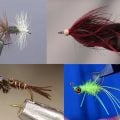How to Tie a Scotty’s McFly
Producer: Tim Flagler
Scotty’s McFly is a great looking and extremely effective smelt pattern invented by Scott Currie from Massey Ontario. Although originally designed to catch smallmouth bass on northern Ontario lakes and rivers, over the years, it has fooled a tremendous variety of fish in both fresh and saltwater. Scotty’s McFly was actually named and made famous by Bill Spicer, host of The New Fly Fisher Show. Bill is a huge fan of the pattern and has used the fly at many of the locations where the show has been shot.
Scotty’s McFly starts with a sturdy foundation, here, a size 4 Mustad 9671 streamer hook. This is paired with a size large, copper-colored Tungsten conehead. Begin by feeding the hook point into the small hole on the conehead. Bring the conehead up the hook shank to behind the eye, then get the assembly firmly secured in the jaws of your tying vise.
.02 lead-free round wire is used for additional weight and to help stabilize the conehead on the hook. While holding the bitter end of the wire, start taking touching forward wraps with it, up the hook shank. After 10 or 12, helicopter the wire to break it off close. Make sure the wraps can slip easily on the hook shank then move the conehead rearward away from the hook eye. Pick up just a small amount of super glue, here Fly Tyers Z-Ment, and apply it to the hook shank immediately behind the eye. Slide the cone forward to against the eye then slide the wire wraps up into the cone, to pin it against the hook eye. Hold the wraps there, under pressure, for a couple of seconds to set the adhesive. Once it sets, you can easily tuck in the remaining wire tail without the wraps simply spinning around the hook shank. At this point, the conehead should be firmly locked in place.
For thread, I’ve loaded a bobbin with a spool of UTC 140 Denier in fluorescent green. Get the thread started on the hook shank, at the back edge of the wire wraps and, after a few rearward turns, snip the excess tag off close.
White marabou is used to form both the tail and the wing of the fly. Select two well-formed, similar looking feathers and strip the lower fibers off of both sides of the stems. You want to strip fibers to the point where the stem begins to markedly thin. Wet both feathers with water or saliva to help control them during tie-in, then align their tips. Measure to form a tail a full hook in length and transfer that measurement rearward to the start of the hook bend. Using the back edge of the wire wraps as a guide, snip the butt ends of the feathers off square. Begin taking thread wraps to anchor the marabou to the top of the hook shank. Keep taking wraps to bind the marabou down, all the way back to the start of the hook bend. Then wrap forward to the wire wraps.
To add some flash to the pattern, snip 3 or 4 strands of pearl Flashabou free from the hank, then find their midpoint. Place the midpoint against the near side of the hook at the location of your tying thread, and start taking wraps to secure it. Make open spiral wraps all the way back to the base of the tail. Pull the forward-pointing portion of the Flashabou back and over to the far side of the hook, and take thread wraps to secure it there. Once again, end with your tying thread at the back edge of the wire wraps. Trim the excess Flashabou off to about the same length as the marabou tail.
Now, take thread wraps over the length of the hook shank to cover everything up and create a nice, bright green underbody on the fly. End with your tying thread right at the base of the tail.
Size large, pearl-colored mylar cord is used to create the overbody of the fly. Measure a segment that extends from the hook eye back to about halfway down to the fly’s tail. While keeping this measurement, snip the segment free. Extract the cotton core from the tubing, if it has it. Slip the tubing over top of the conehead and push it rearward. You want about a hook gap length extending beyond the base of the tail. Take nice tight wraps of tying thread to anchor the tubing to the hook shank. The frayed mylar ends should produce a flashy, little collar at the rear of the fly.
A large whip finish tool makes adding a whip finish at this point a snap. You can also whip finish by hand or use UV cure resin to lock the thread wraps in place before snipping your tying thread free. If you’ve done a whip finish, it’s a good idea to saturate the thread wraps with UV cure resin or here, Sally Hansen Hard as Nails, to make sure they don’t come unraveled.
Now, get your thread started on the hook shank at the back edge of the cone, binding the mylar tubing down in the process. Snip the excess tag off close. Do your best throughout the next couple of steps to keep thread wraps within this narrow band.
Repeat the same procedure as you did with the tail to prep two white marabou feathers for tie-in. This time, measure to form a wing that extends about halfway down the tail of the fly. Using the back edge of the cone as a guide, snip the butt ends of the feathers off square. Giving your bobbin a good counterclockwise spin will make the tying thread jump slightly rearward and catch those very butt ends. Take additional wraps to make sure the marabou is well-secured.
Orange marabou is used to produce a contrasting throat on the fly. Here, a single feather is all that’s needed. Snip the very tip of the feather off then, as you did before, strip off the lower fibers on the thick part of the stem. Here, too, wetting the feather does wonders at keeping it under control. Measure the feather so it’s the same length as the wing and snip the excess off close. Place the snipped-off end on the underside of the hook shank and take nice tight thread wraps to secure it.
Snip another three strands of pearl Flashabou free from the hank, and like before, find their midpoint. Place the midpoint against the near side of the hook and take thread wraps to secure it. Then pull the forward-pointing portion back and to the far side of the hook and secure it there. Continue taking thread wraps to make sure everything is anchored well, but do keep that thread collar narrow. Snip the just-tied-in Flashabou off, even with the tip of the wing.
Once again reach for the super glue and this time apply a liberal coating to the thread band. Take more thread wraps over top of and through the adhesive to help set it. Here you can use your regular whip finish tool to anchor the thread with a 5 or 6 turn whip finish, then snip it free.
Now for the fun part. Push the mylar tubing back over the conehead and the thread band. It should fray a bit in the process to produce a flashy, little collar on the fly. The fly should now look something like this.
Although not essential, I like to apply a good coat of Sally Hansen’s to the mylar tubing at the back edge of the cone, to help stop that portion from fraying. After a quick fluff and blow dry, your Scotty’s McFly is ready to fish.
How to Tie a SBR Light Cahill Nymph
How to Tie a Sculpin Toad Streamer











